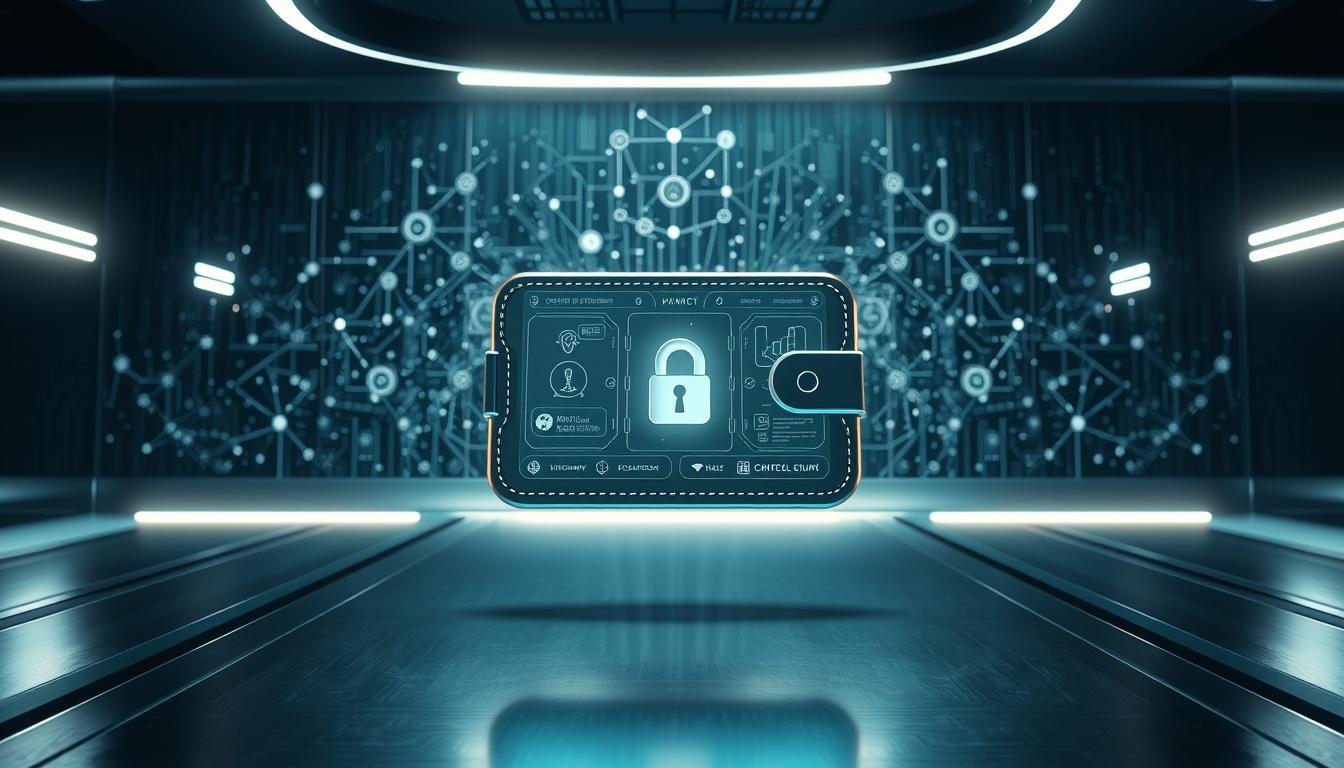Secure Your Crypto with the Safest Wallet
In 2022, over $3.8 billion in cryptocurrency was stolen. This shows how important it is to have a secure bitcoin wallet. You need more than just basic protection. You need a strong security plan to keep your digital assets safe from cyber threats.
Choosing the safest crypto wallet safest crypto wallet is not just a good idea. It’s a must for anyone investing in digital currency. Your wallet is like a digital safe that keeps your cryptocurrency safe from hackers, malware, and unauthorized access.
In this guide, you’ll learn the best ways to pick and keep a secure bitcoin wallet. We’ll show you advanced security methods to protect your digital wealth from cyber risks.

Key Takeaways
- Cryptocurrency theft is a serious and growing threat
- Selecting the right wallet is critical for asset protection
- Multiple layers of security are essential
- Understanding wallet types helps make informed decisions
- Regular security updates are critical for protection
Understanding Crypto Wallet Security Fundamentals
Keeping your digital assets safe is key. You need to know about cryptocurrency wallet security. Start by learning about the different types of wallets and their security features.
Cryptocurrency wallets vary, each with its own security strengths. Let’s look at the main types and how they protect your assets:
- Hardware Crypto Wallet Security Physical devices store private keys offline
- Top protection against online threats
- Safe from hacking and malware
- Software Wallets
- Digital apps on computers or phones
- Easy to use but riskier
- Need strong encryption and updates
- Paper Wallets
- Physical documents with keys
- Offline storage
- At risk from physical damage or loss
Critical Security Features to Evaluate
When picking a crypto wallet, look for these key security features. They help keep your cryptocurrency safe:
| Security Feature | Protection Level | Recommended For |
|---|---|---|
| Multi-Factor Authentication | High | All wallet types |
| Seed Phrase Backup | Critical | Recovery and wallet restoration |
| Encryption Protocols | Essential | Software and online wallets |
Identifying Common Security Vulnerabilities
Knowing the risks is vital for good wallet protection. Common threats include:
- Phishing attacks on private keys
- Malware to steal cryptocurrency
- Weak passwords
- Unsecured networks
Stay ahead with proactive security and keep learning in the ever-changing crypto world.
Hardware Wallets: The Gold Standard for Crypto Security

Hardware crypto wallets are the safest way to protect your digital assets. They offer a level of security that software or online wallets can’t match.
These devices keep your cryptocurrency safe by staying offline. Unlike digital wallets, they don’t connect to the internet. Your private keys are stored in a secure, isolated spot.
- Completely offline storage of cryptocurrency
- Physical protection of private keys
- Resistant to hacking and malware attacks
- Compact and portable design
Brands like Ledger and Trezor have made a big impact on crypto security. Their wallets use top-notch encryption and secure chips. This makes it hard for hackers to get in. You also need to confirm transactions physically, adding more security.
“Your cryptocurrency is only as secure as the wallet protecting it” – Crypto Security Expert
Getting a hardware wallet might seem like a cost. But it’s worth it for the peace of mind it gives. Knowing your digital assets are safe from cyber threats is priceless.
Hardware wallets have many benefits:
Exploring Multi-Signature Wallet Protection
Cryptocurrency security has gotten better with multi-signature wallets. These wallets need more than one private key for transactions. This makes it harder for hackers to get in.
Multi-signature wallets are a new way to keep your crypto safe. They share control among many keys. This makes your investments safer from threats.
Benefits of Multi-Sig Technology
- Enhanced security through distributed key management
- Reduced risk of single-point-of-failure vulnerabilities
- Improved protection against individual key compromises
- Increased accountability in shared wallet scenarios
Setting Up Multi-Signature Authentication
- Choose a compatible multi-signature wallet platform
- Generate multiple private keys from different devices
- Configure the required number of signatures for transactions
- Verify key distribution and backup strategies
Best Practices for Key Management
Good multi-signature wallet use needs smart key management. Keep your private keys safe and separate. Use hardware wallets, offline storage, and encrypted digital backups.
Smart crypto investors know security is about barriers, not perfection.
The power of multi-signature wallets is in their teamwork. They spread risk and need many approvals. This makes your digital assets very safe.
Cold Storage Solutions for Maximum Protection

Protecting your cryptocurrency needs a smart plan for cold storage security. Cold storage is the safest way to keep your digital assets safe from online threats. By keeping your crypto offline, you lower the chance of hacking and unauthorized access.
There are many formats for the best offline crypto storage solutions. They meet different security needs:
- Hardware Wallets: Physical devices that store cryptocurrency private keys
- Paper Wallets: Printed documents containing your crypto wallet information
- Offline Computer Storage: Dedicated computer never connected to the internet
When setting up cold storage security, consider a few key things:
- Physical protection of your storage medium
- Multiple backup locations
- Protection from environmental damage
- Secure key management
Pro tip: Always create multiple backup copies of your cold storage information and store them in separate secure locations.
The top choice for offline crypto storage is hardware wallets. These devices offer great security and easy access. Brands like Ledger and Trezor have strong protection that keeps your digital assets safe from cyber threats.
“Cold storage is not just a recommendation – it’s a necessity for serious cryptocurrency investors.” – Crypto Security Expert
Understanding and using strong cold storage strategies can greatly improve your cryptocurrency investment security.
Finding the Safest Crypto Wallet for Your Needs

Choosing the right secure bitcoin wallet can be tough for crypto fans. Your digital assets’ safety depends on picking a wallet that’s both secure and easy to use.
Exploring crypto wallets needs careful thought. The safest wallet isn’t just about price or features. It’s about keeping your digital investments safe.
Comparing Top Security Features
When looking at crypto wallets, pay attention to these key security points:
- Advanced encryption protocols
- Multi-factor authentication
- Offline storage capabilities
- Regular security updates
Price vs. Security Considerations
Don’t trade off security for cheaper options. Investing in a quality wallet keeps your crypto safe from threats. Here are some price ranges:
- Free web wallets (lowest protection)
- Software wallets ($10-$50)
- Hardware wallets ($50-$250)
User Experience Factors
“The best security is useless if you can’t navigate your wallet comfortably.” – Crypto Security Expert
Look for wallets that are easy to use. They should have good mobile apps and customer support. A good wallet is simple and easy to understand.
Your crypto wallet is like a digital safe. Choose one that keeps your money safe.
Private Key Management and Backup Strategies
Keeping your crypto wallet private keys safe is very important. These keys unlock your digital money. It’s key to know how to manage and back up these keys.
“Your private keys, your crypto. Not your keys, not your coins.” – Cryptocurrency Security Axiom
Creating a good backup plan is key. Here are ways to keep your private keys safe:
- Create multiple secure backup copies
- Use hardware wallets for offline storage
- Implement encrypted digital backups
- Store physical backup copies in fireproof locations
When making a backup plan, think about these important points:
- Seed Phrase Protection: Write down your 12-24 word recovery phrase and store it securely
- Use password-encrypted storage methods
- Avoid digital screenshots or cloud storage
- Consider geographic distribution of backups
No single backup method is perfect. Using different methods can lower risks. This way, you can always get back your digital money.
Advanced Security Measures for Crypto Storage

Keeping your digital assets safe is more than basic security. Crypto wallet protection now includes advanced methods. Knowing these can help you protect your blockchain investments.
Two-Factor Authentication Methods
Two-factor authentication (2FA) adds an extra layer of security. You can choose from several methods:
- Authenticator apps like Google Authenticator
- Hardware security tokens
- Biometric verification
- SMS-based verification codes
Encryption Protocols
Strong encryption is key for crypto wallet safety. Advanced encryption standards like AES-256 offer strong protection. They make your data unreadable to hackers, keeping your assets safe.
Emergency Recovery Options
Be ready for unexpected situations with good recovery plans. Think about using:
- Duress passwords for extra protection
- Time-locked recovery steps
- Distributed key storage
- Backup authentication methods
Your cryptocurrency’s safety depends on proactive security measures and continuous vigilance.
Protecting Against Common Crypto Theft Techniques
Cryptocurrency theft is a big problem. To keep your investments safe, you need to be proactive. You should know about the common ways thieves attack.
Cybercriminals use clever tricks to get to your digital money. Here are the main threats you should be aware of:
- Phishing Attacks: Fake websites and emails that try to steal your secure private keys
- Malware that targets your cryptocurrency wallets
- Social engineering tricks
- Fake mobile apps
- Weaknesses in public Wi-Fi networks
“Your crypto security is only as strong as your weakest link” – Crypto Security Expert
To keep your digital assets safe, follow these important steps:
- Use hardware wallets for big crypto amounts
- Turn on two-factor authentication
- Never share your private keys
- Check if a website is real before giving out your login info
- Keep your software and wallet apps up to date
Real-Time Monitoring and Security Updates
Keeping your cryptocurrency safe is a big job. Real-time monitoring is key to protecting your blockchain wallet. It helps you catch security threats early. Your hardware crypto wallets need constant care to stay safe.
Alert Systems and Notifications
Today’s crypto wallets have smart alert systems. They tell you about every transaction and any odd activity. You get alerts through:
- Email alerts for unusual account movements
- SMS notifications for large transactions
- Push notifications on mobile devices
- Instant messaging app warnings
Regular Security Audits
Doing security audits often is a must. Experts say these checks should cover:
- Checking transaction history
- Verifying wallet access points
- Reviewing connected devices
- Assessing possible vulnerabilities
Firmware Update Importance
Firmware updates are super important for your wallet’s safety. They bring new security fixes to fight off cyber threats. Always update your hardware crypto wallets to stay protected.
Security is not a one-time event, but a continuous process of improvement and vigilance.
Most Read:- Understanding Blockchain in Simple Terms
Conclusion
Protecting your cryptocurrency investments is key. It’s not just about picking one wallet. You need a whole strategy that keeps up with new threats. Your digital assets need strong protection that uses the latest tech and smart habits.
Now you know about the important steps to keep your wallet safe. Things like hardware wallets and multi-signature checks help a lot. Each step you take adds a layer of protection against hackers.
The world of cryptocurrency is always changing. So should your way of keeping it safe. Keep up with new security tech, update your methods often, and always put your digital money’s safety first. Being careful is the best way to keep your crypto safe.
In the fast-changing world of digital money, picking the right wallet and using strong security is essential. Take charge of your financial future by using the best security for your crypto assets.
FAQ
What is the safest type of crypto wallet?
Hardware wallets are the safest for storing crypto. They keep your digital assets safe from hackers and malware. Brands like Ledger and Trezor offer top security by keeping your private keys offline.
How do I protect my private keys?
Keeping your private keys safe is key. Use a hardware wallet for offline storage. Make secure backups and never share your keys. Use multi-signature wallets and split your backup across safe locations.Always use strong passwords and enable two-factor authentication.
What is cold storage for cryptocurrency?
Cold storage means keeping your crypto offline. It includes hardware wallets, paper wallets, or offline computers. It’s the safest way to protect your assets from hackers.
Are multi-signature wallets more secure?
Yes, multi-signature wallets add extra security. They need multiple signatures for a transaction. This protects your assets even if one key is compromised.
How often should I update my crypto wallet’s security?
Update your wallet’s security often. This means: – Update wallet firmware monthly – Check for security patches – Review and update access credentials – Do security audits – Stay updated on security threats
What are the most common crypto theft techniques?
Common theft methods include phishing, malware, and fake apps. Protect yourself with reputable wallets and two-factor authentication. Stay alert online.
Can I recover my crypto if my wallet is lost or stolen?
Recovery depends on your backup strategy. If you saved your seed phrase securely, you can likely restore your wallet. Keep backups in multiple safe places.


